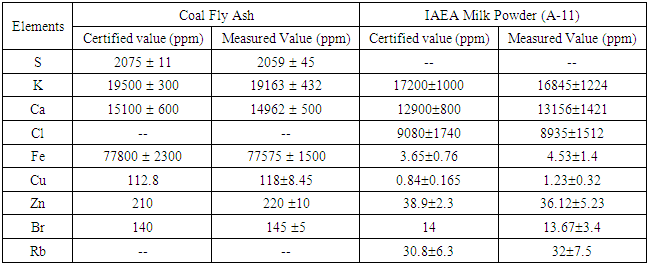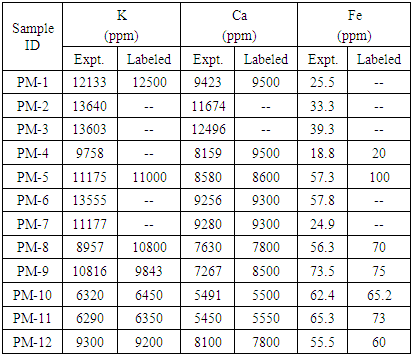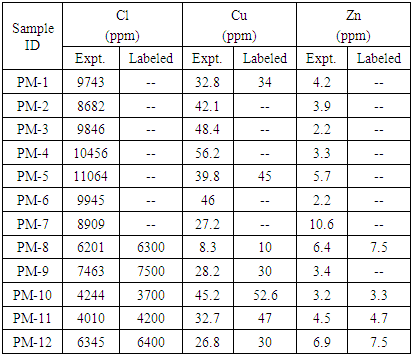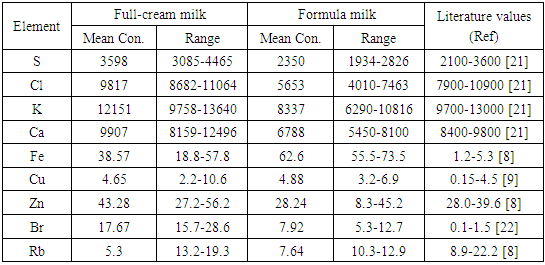-
Paper Information
- Paper Submission
-
Journal Information
- About This Journal
- Editorial Board
- Current Issue
- Archive
- Author Guidelines
- Contact Us
Food and Public Health
p-ISSN: 2162-9412 e-ISSN: 2162-8440
2020; 10(4): 81-87
doi:10.5923/j.fph.20201004.01
Received: Sep. 29, 2020; Accepted: Oct. 17, 2020; Published: Oct. 28, 2020

Elemental Analysis of Formula Milk and Full-Cream Powder Milk in Bangladesh
R. Khatun1, S. Akter1, A. N. Monika2, M. M. Rahman3, M. M. Ahasan2
1Medical Physics Division, Atomic Energy Centre, Dhaka, Bangladesh
2Institute of Nuclear Medical Physics, AERE, Savar, Dhaka, Bangladesh
3Accelerator Facilities Division, Atomic Energy Centre, Dhaka, Bangladesh
Correspondence to: R. Khatun, Medical Physics Division, Atomic Energy Centre, Dhaka, Bangladesh.
| Email: |  |
Copyright © 2020 The Author(s). Published by Scientific & Academic Publishing.
This work is licensed under the Creative Commons Attribution International License (CC BY).
http://creativecommons.org/licenses/by/4.0/

An accelerator- based elemental study of powder milk, i.e. formula milk and full-cream powder milk was performed using proton induced X-ray emission (PIXE) technique. Concentration levels of various trace elements in twelve (12) different brands of milk samples including formula milk and full-cream powder milk that were commonly consumed in Bangladesh, were determined to reveal what types of nutrients might be passed from powder milk to babies. The experiments have been done with the 3 MV horizontal type (KN 3000) positive ion Van de Graaff accelerator at the Atomic Energy Centre, Dhaka (AECD). Full-cream powder milk samples were characterized by higher concentrations of S, Cl, K, Ca and Br compare to that in formula milk samples by overlapping concentration ranges of their elements. The concentration of elements examined in this work falls within or nearer the values reported in the literature except for Fe, Zn and Br as indicated earlier. Special interest of this research was to search for certain toxic elements which include Cd, Hg, Pb etc. because of their negative roles in enhancing infant mortality rates, but none of them was detected in both the cases. The Standard Reference Material 1633b (Coal Fly Ash) and IAEA Milk Powder (A-11) were also examined, and the measured values of trace elements were compared with the given certified values and found to be compatible.
Keywords: Formula milk, Full-cream Powder milk, Trace elements, PIXE
Cite this paper: R. Khatun, S. Akter, A. N. Monika, M. M. Rahman, M. M. Ahasan, Elemental Analysis of Formula Milk and Full-Cream Powder Milk in Bangladesh, Food and Public Health, Vol. 10 No. 4, 2020, pp. 81-87. doi: 10.5923/j.fph.20201004.01.
Article Outline
1. Introduction
- The dietary habits depend on so many factors like socio-economic status, regional customs, traditions, religion and so on. Milk is the first food for human being that serves as the main source of essential nutrients required for the biological functions and growth during early stages of life [1]. Trace elements play the important roles in the functioning of many proteins, hormones, enzymes, and other large molecules. However, some essential metals become “toxic” when their concentration is increased, especially the levels exceeding by 40-to-200-fold [2]. If their intakes via food chain cross the permissible levels [3], toxicity may be a problem. The severity of toxicity depends on nature and concentration of the elements, body resistance, and antagonistic effects of other chemical contaminants [4]. Milk and milk products are important components of diet for human beings, specially for growing children and is an important dietary source of minerals also. The concentration level of trace elements in both kinds of powder milk may vary with the local geochemical conditions, food chain, etc. All the efforts should be made so that children can take a well balanced nutritious food. United Nations Sub-committee on Nutrition demands that it is impossible to meet 100% recommended dietary allowances (RDA) of micronutrients from dietary sources alone [5]. Hence, nutritional supplements are mandatory to improve physical growth and mental development and to prevent occurrence of common day-to-day infections. Powder milk, i.e. formula milk and full-cream powder milk may play the important role as a supplement to meet the requirements. Elemental analysis of the powder milk is important for many reasons. The assessment of essential and heavy metal toxicity will provide sufficient knowledge to understand the nutritional status of milk powder and their effects on baby health. In the developed countries, food quality analysis is a routine work and is done to ensure the health and quality of their daily life [6].The development of modern technology and increasing industrial activities may introduce the pollution of food, water, air, soil and so on. Hence, it is imperative to know whether the milks commonly used as substitutes or supplements of human milk for babies, have the adequate amount of essential trace elements and also the concentration of elements with harmful effects is below safety limits. Trace elements in milk are evidently of prime interest from the nutritional point of view, and also from the view-point of their effect on milk processing and dairy technology. It has long been known that trace elements in powder milk may be significantly altered through handling of the milk or through various technological processes. Additionally, the relevant companies have embarked on advertisement campaigns concerning the nutritional quality of their products. In many cases, the manufacturers of these instant milk powders advocate their products as having been fortified with several mineral elements. However, the information of individual mineral element is often not indicated on the product labels of this milk powder [7,8].Commercial dried milk and infant formula are deliberately fortified with essential elements such as iron, zinc, and copper to ensure proper nutrients provision [9]. The assessment of heavy metal exposure in the infants’ diets is very essential so as to have a clear picture of the intakes, utilization, and retention of essential as well as toxic nutrients. Infants and young children may absorb 50% of dietary toxic metals as compared with only 10% by adults [10]. Heavy metals are dangerous because they tend to bioaccumulate in a biological organism faster than being metabolized or excreted [11]. As far as infant foods are concerned, the main issue is whether formula products consumed by babies, contain sufficient amount of essential nutrients. Such formulations should contain all the essential trace elements at least in those levels that are present in human milk because milk formulas are used as substitute of human milk [12]. Hence the elemental analysis of formula milk and full-cream powder milk is necessary for adjudging its suitability and to obtain information on the quantities of trace elements present in powder milk, i.e. formula milk and full-cream powder milk in adequate level or not. The aim of the present study was to analyze the infant formula milk and in full cream powder milk samples collected from different local markets of Bangladesh and to determine the levels of essential and toxic trace elements present in them to obtain the nutritional judgment about them.
2. Methodology
2.1. Sample Collection and Preparation
- The commercially available powder milk samples of twelve different brands were collected from different supermarkets in Dhaka city. Among them, five are formula milk and the other seven are full-cream powder milk. The samples were stored in airtight plastic containers at ambient temperature until the completion of analysis. Before pelleting, the powder milk samples were freeze dried at about -85°C temperature and 133x10-3 mbar pressure to attain a constant mass. This milk powder was made into pellets of about 7mm dia with a hand press pellet maker and labeled and kept in desiccators. Freeze drying is a convenient technique, which reduces the background in the spectrum and improves the sensitivity [13]. At every stage, minimum sample handling was ensured to avoid contamination.
2.2. Method of Analysis
- Proton induced X-ray emission (PIXE) technique was employed to analyze the powder milk samples to study which kind of nutrients are present in them. The main feature of PIXE method is to ionize an atom to produce characteristic X-ray and to detect them by the Si(Li) detector. The PIXE analysis provides high Z elements such as S, Cl, K, Ca, Fe, Cu, Zn, Ga, Br, Ru, Pb etc. and gives the accurate concentration of the most of the elements present in the samples with high accuracy [14]. MAESTRO software was used to save the X-ray emission spectrum and GUPIX with DAN32 interfacing software for analyzing PIXE spectra of our desired purpose [15]. The peak of the pulse height spectra gives information of an element and its concentration if it corresponds to the full - energy absorption peak of that element. The peak location is a measure of the photon energy and the peak area represents the number of photons. Measurements were done using internal beam technique and the characteristic X-rays emitted from the sample upon bombardment with 2.5 MeV proton beam were detected using a 30 mm2 Si(Li) detector and associated electronic setup for routine analysis. The detector resolution was 165 eV at 5.9 keV. The count rate was reduced using a 0.147 μm thick Mylar absorber. The dead time of the measurements was generally less than 5%. A 200 μg/cm2 gold diffuser foil was used to homogenize the beam onto the target samples and current was in the range of 5-10 nA.
3. Results and Discussions
- Now-a-days many important advances in analytical techniques for trace element analyses in biological samples have occurred. These analyses are still commonly subject to significant errors due to mass interferences, high risk of contamination, and lack of suitable reference materials. This study investigated a wide variety of element concentrations of powder milk, using a highly sensitive analytical method which enables determination of very low concentrations of elements with high precision.The Minimum Detection Limits (MDL) for this method usually depends on the matrix constituents of the sample. It is, therefore, necessary to keep attention of the MDLs to obtain quality results. Before doing any experiment, it is essential to validate the method accurately and is also important to demonstrate the quality of the data that are being used for decision making. It is necessary to present the data with the confidence that they really reflect the human health and thus environment [16-17] to convince the government or industries to take appropriate steps. However, sometimes it is difficult to find the standards of similar matrix description to the field of respective samples for quality assurance practice. In such cases, validation and good knowledge of the fundamentals of the techniques are not necessarily sufficient to obtain good results; careful attention to details must be needed on the part of the analyst to ensure the quality of results.
3.1. Method of Validation
- The validity of the method has been checked by analysing two standard samples: Standard Reference Material 1633b (Coal Fly Ash) from National Institute of Standard and Technology (NIST) and IAEA Milk Powder (A-11) from IAEA. Measurements were taken several times and the obtained values are presented in Table 1.
|
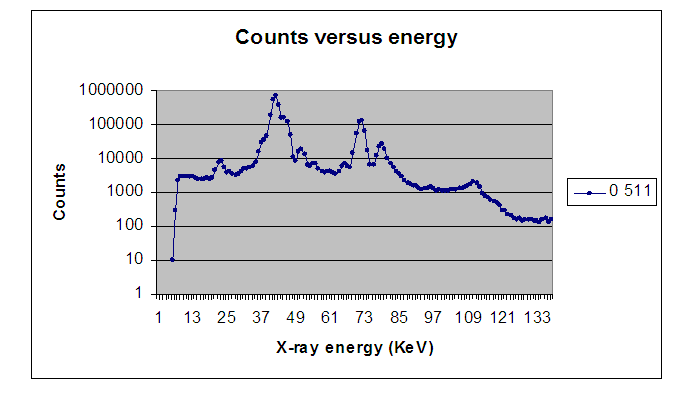 | Figure 1. PIXE spectra for standard reference material |
3.2. Experimental Details
- Milk is a valuable source of essential minerals but some toxic elements may be accidently added during handling, processing, and remixing of milk. The information on food consumption by the children is also essential for assessing the food needs for them at national/regional level. No realistic policies on food production, procurement and distribution can be formulated without a thorough knowledge of food habits of the people. Healthy children do provide a solid foundation to the society in order to ensure optimal human resource development of a country [18]. Thus the powder milk and milk products may be used as supplements and can play an important role in human nutrition, i. e. child nutrition. Table 2 and Table 3 represent the obtained and manufacturer labeled concentrations of K, Ca, Fe, Cu, Zn and Cl in the milk samples. Table 4 shows the concentration ranges of elements in full-cream powdered milk and in formula milk with some literature values.
|
|
|
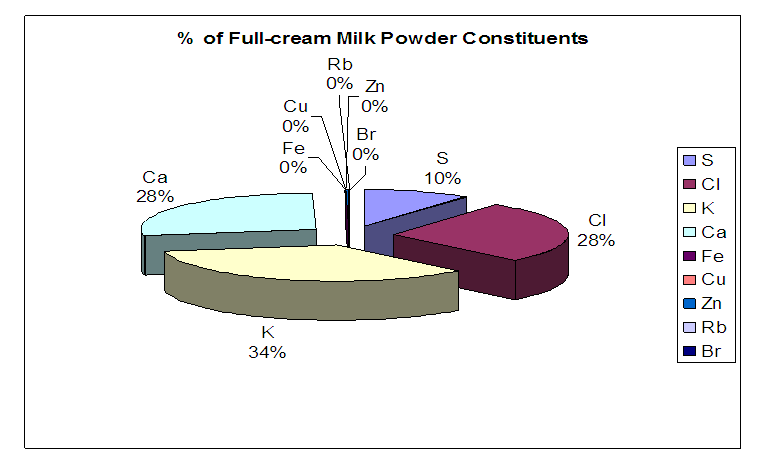 | Figure 1A. Elemental concentration of full-cream Powder Milk |
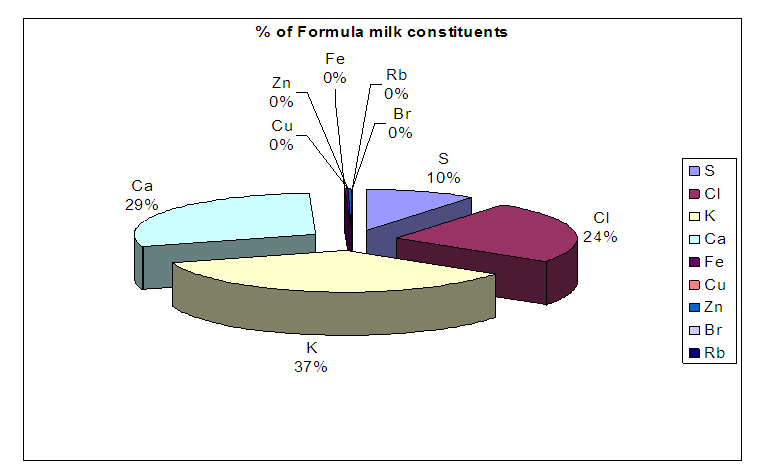 | Figure 1B. Elemental concentration of formula milk |
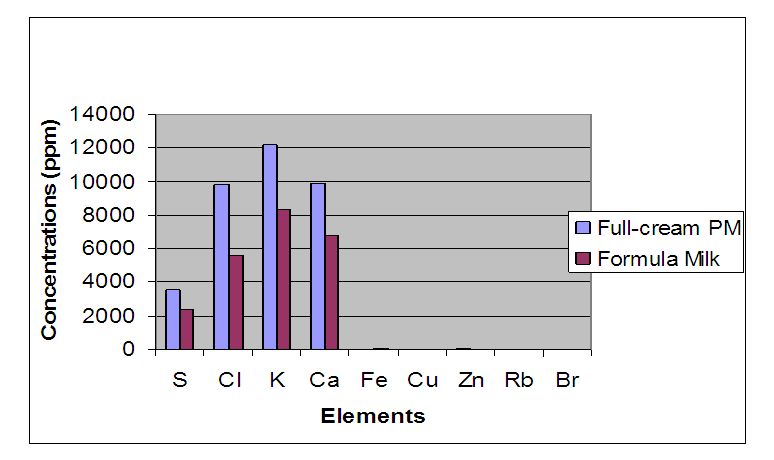 | Figure 2. Comparison of powder milk constituents |
4. Conclusions
- The results of this study provide valuable information of various elements present in different powdered milk (formula and full cream) samples available in the market. It was observed that the determined values were within the acceptable limits. The present study demonstrates the levels of essential elements S, Cl, K, Ca, Fe, Cu, Zn, Br and Rb were found in the analyzed samples with a large variation interval. Full-cream powder milk samples are characterized by higher concentrations of S, Cl, K, Ca and Br, when compared to that in formula milk samples by overlapping concentration ranges of their elements. The concentration of elements examined in this work falls within or nearer the values reported in the literature except for Fe, Zn and Br as indicated earlier. The level of K is the maximum and Cu is the minimum for all the cases of milk samples. The Fe level concentration in full-cream powdered milk is found lower than in formula milk samples and this may be due to the fortification of formula milk. The milk samples contained considerable amounts of calcium, while potassium levels were well above the required limits. Copper levels were slightly lower than the permissible allowances. The concentrations of zinc in the milk samples were up to the mark for both the cases. Infant milk formulae had better iron levels as compared to other milk samples. Moreover, since infants are potentially more susceptible to metals, infant foods should be monitored regularly and checked for contamination by toxic metals as well as for levels of essential trace elements. Hence, the outcome of this research work will provide sufficient knowledge to understand the nutritional status of milk powder and their effects on human health.
ACKNOWLEDGEMENTS
- The authors wish to thank all the members of Accelerator Facilities Division for their continuous help during the course of this study. This work was partly financially supported by the Dutch Bangla Bank Foundation Limited, under the DBBL Fellowship Programme is also thankfully acknowledged.
 Abstract
Abstract Reference
Reference Full-Text PDF
Full-Text PDF Full-text HTML
Full-text HTML